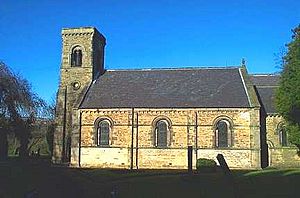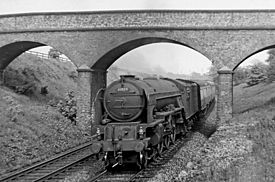Croxdale facts for kids
Croxdale is a village in County Durham, England. It's about 3 kilometers (2 miles) south of Durham City. The village is on the A167 road, which used to be part of the important Great North Road. The East Coast Main Line railway also runs through Croxdale, crossing the Croxdale Viaduct, built in 1872, just north of the village. A long-distance walking path called the Weardale Way goes through the nearby Croxdale Hall estate.
Contents
History of Croxdale
How Croxdale Started
Croxdale began as a small group of buildings around Croxdale Hall. This hall is about half a mile northeast of where the village is today. The name "Crokesteil" was first written down in 1195. It might come from a Viking named Krokr. The "tail" part could refer to the way the river bends like a tail.
The Salvin Family and Croxdale Hall
The ownership of Croxdale can be traced back to 1291. At that time, a person named Roger Routhberi owned it. By the 1350s, Robert de Whalton, who was a treasurer in Brittany, owned Croxdale. His granddaughter, Agnes, married Gerard Salvin in 1409. This is how the Croxdale estates came into the Salvin family. They still own Croxdale Hall and the land around it today. For many centuries, the owner of Croxdale Hall has been named Gerard Salvin. The family was known for being Roman Catholics. They had to be very careful and keep a low profile for a long time because of difficulties faced by Catholics.
The original part of Croxdale includes Croxdale Hall and its surrounding buildings. These include a chapel, farmhouses, and a hay barn. Many of these buildings are very old and protected. You can see them easily by walking along the Weardale Way public path through the estate.
Burn Hall's Story
Just north of Croxdale, to the left of the A167 road, is Burn Hall. This building was designed in 1821 by an architect from Durham named Ignatius Bonomi. It was also built for the Salvin family. However, it became too expensive for the family to own and look after two large halls. So, in 1926, they sold Burn Hall. It was bought by Roman Catholic missionaries. They used it to train boys to become missionary priests. In 1995, it was sold again and turned into fancy apartments.
The Rise of Coal Mining
The modern village of Croxdale grew because of coal mining. Croxdale Pit, a coal mine, opened in 1845. The Salvin family from Croxdale Hall started this mine. But it only operated for a few decades, closing by 1870. Around this time, St. Bartholomew's church was built by Salvin for the miners. These workers came to the area to work in the mine. The old chapel on the Croxdale Estate was given up for the church site. The old chapel is now used as a special chapel for the Salvin family. The churchyard of St. Bartholomew's is where James Finlay Weir Johnston is buried. He was the person who started Durham Johnston School in nearby Durham City.
In 1875, coal mining returned to Croxdale. The Weardale Iron and Coal Company opened Croxdale Colliery. This mine was just south of Sunderland Bridge. It produced coal, fireclay, and coke. At its busiest, it employed over 900 workers. Houses were built for the miners and their families. A Methodist chapel was finished in 1877, and a school was built in 1878-79. This old school building is now the community center. St. Bartholomew's church was also made bigger in 1878. The main streets in the new mining village were named after the people who helped pay for the houses. These streets were Salvin Street, and Rogerson, Johnson, and Foster Terraces. The colliery was so successful that John Rogerson, one of the company directors, even rented Croxdale Hall from the Salvin family for a while. The colliery closed in 1934.
Until 1938, Croxdale had its own railway station. Trains from the North Eastern Railway stopped there.
After the Wars
During World War 2, a factory that made military supplies was in the village. After the war, this factory became the NESS furniture factory. This factory closed in 2015. From 2017, the old factory building was changed into a business center. It now has offices, storage areas, and places for distribution. There are also plans to possibly add housing there later.
Community Life in Croxdale
Village Amenities
The village has a small corner shop. This shop used to be the village post office. There are also two pubs. One is called The Daleside, which is a traditional English pub. The other is The Croxdale Inn, which is also an Indian restaurant and bar called Penash.
For children, there is a play park in the village. This park was paid for by money raised from fun summer days. The village also has a football pitch and allotments, which are small plots of land for growing vegetables.
Important Buildings
The church, built in 1845, is dedicated to St. Bartholomew. It was built in the Norman style, which is a type of old English architecture. It has a nave, a chancel, and a tower at the west end. It is located at the western edge of the village of Sunderland Bridge.
The community center is located in the old school hall. It is a busy place that hosts different clubs and activities. On election days, it also serves as the place where people go to vote.



